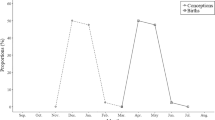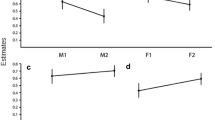Abstract
Southern elephant seals Mirounga leonina display extreme sexual dimorphism. In addition females show great variation in size and stored resources at parturition. Therefore they present an excellent opportunity for examination of responses of sex ratio to resource availability. We studied the relationships between the size of southern elephant seal females at parturition and the size and sex of their pups at South Georgia over four breeding seasons. We found a large individual variation in maternal post-partum mass (range 296–977 kg, n=151). Larger mothers gave birth to larger pups, irrespective of the sex of their pup. Male pups were on average 14% larger than females at birth and consequently more costly to bring to parturition. Our results suggest that female southern elephant seals must weigh more than 300 kg if they are to breed at all, and more than 380 kg if they are to give birth to a male pup. Above this threshold the proportion of males among offspring rapidly increases with maternal mass, and stabilizes at a level not significantly different from parity. These results show that smaller females of southern elephant seals vary offspring sex ratio in a way that is consistent with theories on adaptive offspring sex ratio. A smaller mother with a male foetus may benefit from terminating her pregnancy and allocating the resources she saves to her own growth. She could then give birth to and raise a larger pup in the subsequent season.
Similar content being viewed by others
References
Anderson SS, Fedak MA (1987) Grey seal, Halichoreus grypus, energetics: females invest more in male offspring. J Zool Lond 211:667–679
Arnbom TA, Lunn NJ, Boyd IL, Barton T (1992) Aging live Antarctic fir seals and southern elephant seals. Mar Mamm Sci 8:37–43
Arnbom TA, Fedak MA, Boyd IL, McConnell BJ (1993) Variation in weaning mass of pups in relation to maternal mass,post-weaning fast duration, and weaned pup behaviour in southern elephant seals (Mirounga leonina) at South Georgia. Can J Zool 71:1772–1781
Baker JR, Fedak MA, Anderson SS, Arnbom T, Baker R (1990) Use of tiletamine-zolazepam mixture to immobilise wild grey seals and southern elephant seals. Vet Rec 126:75–77
Bodkin JL, Mulcahy D, Lensink CJ (1993) Age-specific reproduction in female sea otters (Enhydra lutris) from south-central Alaska: analysis of reproductive tracts. Can J Zool 71:1811–1815
Caley MJ, Nudds TD (1987) Sex ratio adjustment in Odocoileus: does local resource competition play a role? Am Nat 129:452–457
Clutton-Brock TH (1991) The evolution of parental care. Princeton University Press, Princeton
Clutton-Brock TH, Albon SD (1982) Parental investment in male and female offspring in mammals. In: King's College Sociobiology Group (eds) Current problems in sociobiology. Cambridge University Press, Cambridge, pp 223–247
Clutton-Brock TH, Iason GR (1986) Sex ratio variation in mammals. Rev Biol 61:339–374
Clutton-Brock TH, Guinness FE, Albon SD (1982) Red deer: behaviour and ecology of two sexes. University of Chicago Press, Chicago
Clutton-Brock TH, Albon SD, Guinness FE (1984) Maternal dominance, breeding success, and birth sex ratios in red deer. Nature 308:358–360
Clutton-Brock TH, Albon SD, Guinness FE (1986) Great expectations: dominance, breeding success and offspring sex ratios in red deer. Anim Behav 34:460–471
Cox DR (1970) The analysis of binary data. Methuen, London
Fedak MA, Arnbom TA, McConnell BJ, Chambers C, Boyd IL, Harwood J, McCann TS (1994) Expenditure, investment and acquisition of energy in southern elephant seals. In: Le Boeuf BJ, Laws RM (eds), Elephant seals: population ecology, behavior, and physiology. University of California Press, Berkeley, pp 354–373
Francis JM, Heath CB (1991) The effects of El Nino on the frequency and sex ratio of suckling yearlings in the California sea lion. In: Trillmich F, Ono KA (eds) Pinnipeds and El Nifio. Springer, Berlin Heidelberg New York, pp 193–201
Gosling LM (1986) Selective abortion of entire litters in coypu: adaptive control of offspring production in relation to quality and sex. Am Nat 127:772–795
Green WCH, Rothstein A (1991) Sex bias or equal opportunity? Patterns of maternal investment in bison. Behav Ecol Sociobiol 29:373–384
Hosmer DW Jr, Lemeshow S (1989) Applied logistic regression. John Wiley and Sons, New York
Huber HR (1987) Natality and weaning success in relation to age of first reproduction in northern elephant seals. Can J Zool 65:1311–1316
Ingham SE (1967) Branding elephant seals for life history studies. Polar Rec 13:447–449
Iverson SJ, Oftedal OT, Boness DJ (1991) The effect of El Nino on pup development in the California sea lion (Zalophus californianus) I Early postnatal growth. In: Trillmich F, Ono KA (eds), Pinnipeds and El Nino. Springer, Berlin Heidelberg New York, pp 180–184
Johnson SD (1994) Sex ratio and population stability. Oikos 69:172–176
Kent JP (1992) Birth sex ratios in sheep over six lambing seasons. Behav Ecol Sociobiol 30:151–155
Kojola I, Eloranta E (1989) Influences of maternal body weight, age, and parity on sex ratio in semidomesticated reindeer (Rangifer t. tarandus). Evolution 43:1331–1336
Laws RM (1953) The elephant seal (Mirounga leonina Linn.) I. Growth and age. Falkland Is Dep Surv Sci Rep 8:1–62
Laws RM (1956) Growth and sexual maturity in aquatic mammals. Nature 178:193–194
Le Boeuf BJ, Condit R, Reiter J. (1989) Parental investment and the secondary sex ratio in northern elephant seals. Behav Ecol Sociobiol 25:109–117
Lunn NJ, Boyd IL (1993) Effect of maternal age and condition on parturition and the perinatal period of Antarctic fur seals. J Zool Lond 229:55–67
Manly BFJ (1991). Randomization and Monte Carlo methods in biology. Chapman and Hall, London
Matthews LH (1929) The natural history of the elephant seal. Discovery Rep 1:233–256
McCann TS (1980) Population structure and social organization of southern elephant seals, Mirounga leonina. Biol J Linn Soc 14:133–150
McCann TS (1981) The social organization and behaviour of the southern elephant seals, Mirounga leonina. Ph.D.thesis, University of London
McCann TS, Fedak MA, Harwood J (1989) Parental investment in southern elephant seals, Mirounga leonina. Behav Ecol Sociobiol 25:81–87
Ono KA, Boness DJ (1991) The influence of El Niño on mother-pup behaviour, pup ontogeny, and sex ratios in the California sea lion. In: Trillmich F, Ono KA (eds), Pinnipeds and El Nino. Springer, Berlin Heidelberg New York, pp 185–192
Payne RW, Lane P (1987) Genstat 5 reference manual. Clarendon Press, Oxford
Reiter J, Le Boeuf BJ (1991) Life history consequences of variation in age at primiparity in northern elephant seals. Behav Ecol Sociobiol 28:153–160
Rutberg AT (1986) Lactation and fetal sex ratios in American bison. Am Nat 127:89–94
Simpson MJA, Simpson AE (1982) Birth sex ratios and social rank in rhesus monkey mothers. Nature 300:440–441
Skogland T (1986) Sex ratio variation in relation to maternal condition and parental investment in wild reindeer, Rangife t. tarandus. Oikos 46:417–419
Sydeman WJ, Huber HR, Emshe SD, Ribic CA, Nur N (1991) Age-specific weaning success of northern elephant seals in relation to previous breeding experience. Ecology 72:2204–2217
Thomas DC, Barry SJ, Kiliaan HP (1989) Fetal sex ratios in caribou: maternal age and condition effects. J Wildl Manage 53:885–890
Trexler JC, Travis J (1993) Nontraditional regression analysis. Ecology 74:1629–1637
Trillmich F (1986) Maternal investment and sex-allocation in the Galapagos fur seal, Arctocephalus galapagoensis. Behav Ecol Sociobiol 19:157–164
Trivers RL, Willard DE (1973) Natural selection of parental ability to vary the sex ratio of offspring. Science 179:90–92
Verme LJ (1969) Reproductive patterns of white-tailed deer related to nutritional plane. J Wildl Manage 33:881–887
Verme LJ (1983) Sex ratio variation in Odocoileus: a critical review. J Wildl Manage 47:573–582
Wolff JO (1988) Maternal investment and sex ratio adjustment in American bison calves. Behav Ecol Sociobiol 23:127–133
Author information
Authors and Affiliations
Additional information
Communicated by F. Trillmich
Rights and permissions
About this article
Cite this article
Arnbom, T., Fedak, M.A. & Rothery, P. Offspring sex ratio in relation to female size in southern elephant seals, Mirounga leonina . Behav Ecol Sociobiol 35, 373–378 (1994). https://doi.org/10.1007/BF00165838
Received:
Accepted:
Issue Date:
DOI: https://doi.org/10.1007/BF00165838




